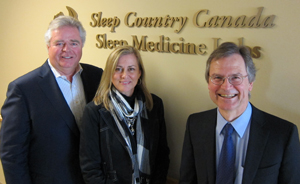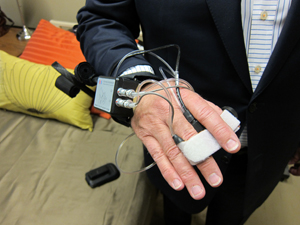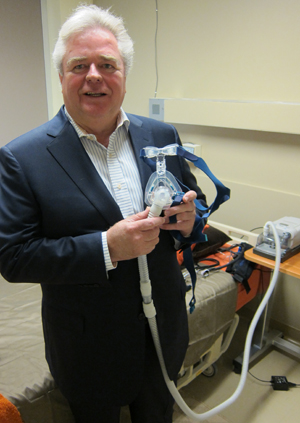 UHN and Sleep Country Canada have teamed up to create the Sleep Country Canada Sleep Medicine Labs, which will improve national awareness of sleep disorders and their implications on personal health. The lab will treat patients suffering from both common and rare sleep disorders, from sleep apnea to restless leg syndrome to insomnia. Sleep issues are estimated to affect about five million Canadians.
UHN and Sleep Country Canada have teamed up to create the Sleep Country Canada Sleep Medicine Labs, which will improve national awareness of sleep disorders and their implications on personal health. The lab will treat patients suffering from both common and rare sleep disorders, from sleep apnea to restless leg syndrome to insomnia. Sleep issues are estimated to affect about five million Canadians.
"There is no other sleep lab in the world that has the kind of patient clientele we serve," says Dr. Douglas Bradley, Director of the Sleep Country Canada Centre for Sleep Health and Research. "This is a medically intensive sleep laboratory; some of our patients suffer from heart disease or respiratory failure, which has a significant negative impact on their sleep."
So what happens in a sleep lab?
 Patients stay overnight in rooms that are free of light, disruption and noise. Sleep is recorded through observation and testing; recordings of brain activity are taken to identify a person's sleep pattern and other conditions, such as sleep apnea. The support provided by Sleep Country Canada will provide new state-of-the-art equipment for monitoring of sleep and sleep disorders and help the centre to intensify its research and improve treatment of sleep disorders.
Patients stay overnight in rooms that are free of light, disruption and noise. Sleep is recorded through observation and testing; recordings of brain activity are taken to identify a person's sleep pattern and other conditions, such as sleep apnea. The support provided by Sleep Country Canada will provide new state-of-the-art equipment for monitoring of sleep and sleep disorders and help the centre to intensify its research and improve treatment of sleep disorders.
This is the only sleep lab in Ontario capable of monitoring blood pressure, cardiac output and carbon dioxide levels simultaneously and continuously during sleep, using a specialized portable device. The device has a probe which wraps around the fingers and a blood pressure-like cuff which wraps around the arm, from which signals are collected and recorded on a computer, in addition to other regular sleep study data.
 Sleep apnea and heart failure
Sleep apnea and heart failure
Dr. Bradley has been studying the correlation between heart failure and obstructive sleep apnea for more than twenty years. As the director of this lab and TRI and Mt. Sinai sleep research labs, he and his team have made a number of pioneering discoveries:
- Heart failure patients with untreated sleep apnea are more likely to die than those without this sleep disorder.
- Heart function can be significantly improved in patients with congestive heart failure and (obstructive) sleep apnea with a simple portable device, the continuous positive airway pressure (CPAP). This is a mask which is placed over a patient's nose and is connected to a blower pump during sleep to keep the air flowing into the patient's throat and lungs.
- Uncontrollable high blood pressure can be lowered by treating sleep apnea.
- Treating (obstructive) sleep apnea in patients with strokes improves mobility and physical function.
- The fluid retained in the legs during the day, due to, for example, prolonged sitting, can flow to and through the neck during the night, causing a narrowing of the throat. The amount of fluid that flows into the neck is strongly linked to the severity of sleep apnea. This means that new treatments aimed at reducing fluid retention in the legs and its flow into the neck at night could be an effective treatment. The group is now testing whether water pills might reduce fluid retention in the legs during the day.
It is estimated that there are 500,000 Canadians are living with heart failure and 50,000 new patients are diagnosed each year. The vast majority of heart failure patients across the country are not being assessed for the diagnosis of sleep apnea and, as a result, are not being treated for it.
